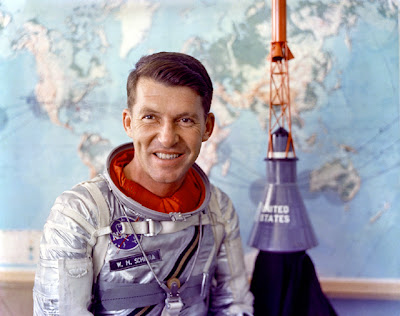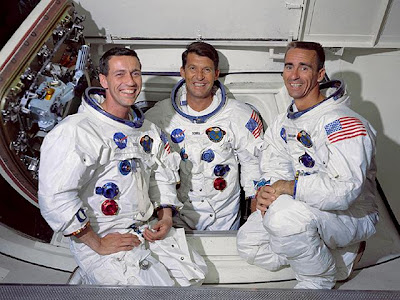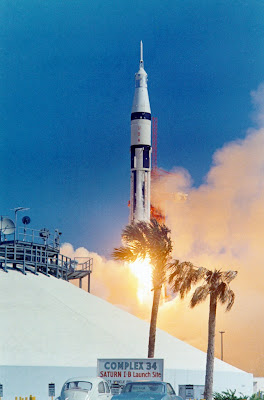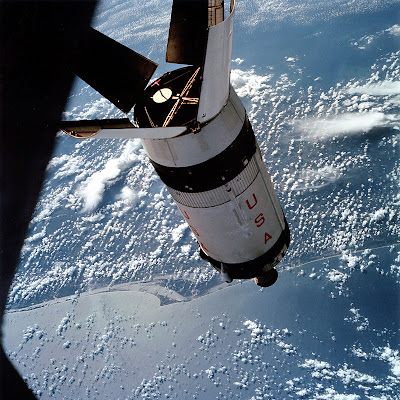CAPT Wally Schirra, USN-Ret.: 12 Mar 1923 – 3 May 2007
I had always wanted to go to the Navy. As a young kid, I was intrigued by a Naval Officer with the beautiful brown shoes and sharp gold wings.- Wally Schirra
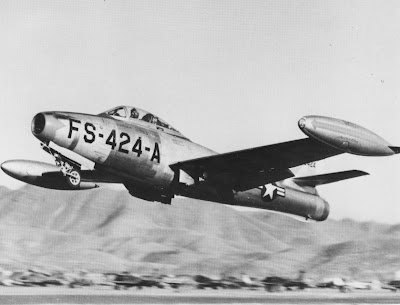 WW1 to earn his wings and his mom was a wing walker), Wally Schirra entered the Navy via Annapolis (class of 45) and after commissioning, served the final days of the war on the cruiser USS Alaska (CB-1). Entering flight training after the war, Schirra ended up in fighters and when the Korean War began in 1950, was dispatched to fly F-84’s as an exchange pilot with the Air Force’s 154th Fighter Bomber Squadron, 136th Bombing Wing. Flying over 90 combat missions during the period 1951-52 he earned the DFC, and Air Medal (w/oak leaf cluster) and was credited with downing one MiG-15 while damaging two others.
WW1 to earn his wings and his mom was a wing walker), Wally Schirra entered the Navy via Annapolis (class of 45) and after commissioning, served the final days of the war on the cruiser USS Alaska (CB-1). Entering flight training after the war, Schirra ended up in fighters and when the Korean War began in 1950, was dispatched to fly F-84’s as an exchange pilot with the Air Force’s 154th Fighter Bomber Squadron, 136th Bombing Wing. Flying over 90 combat missions during the period 1951-52 he earned the DFC, and Air Medal (w/oak leaf cluster) and was credited with downing one MiG-15 while damaging two others. Navy Service – Test and Operations
Navy Service – Test and Operations
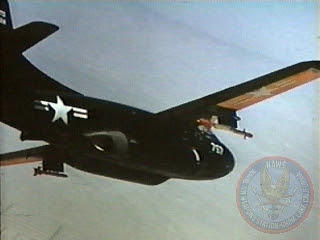 Back with the Navy, he was part of the Sidewinder development team at China Lake. His test career almost came to an early end during this period though. Flying an F3D night fighter, Schirra was the first to fire a Sidewinder at a drone target – with almost disastrous results. The missile went out of control and started to loop around to chase the plane; Schirra’s response was to make an even faster/tighter turn to stay on its tail. Later, as a test pilot, he flew a variety of the notoriously difficult early jet aircraft that came to existence in the 1950s. One of the signatory aircraft was the F7U Cutlass – whose nicknames of “Ensign
Back with the Navy, he was part of the Sidewinder development team at China Lake. His test career almost came to an early end during this period though. Flying an F3D night fighter, Schirra was the first to fire a Sidewinder at a drone target – with almost disastrous results. The missile went out of control and started to loop around to chase the plane; Schirra’s response was to make an even faster/tighter turn to stay on its tail. Later, as a test pilot, he flew a variety of the notoriously difficult early jet aircraft that came to existence in the 1950s. One of the signatory aircraft was the F7U Cutlass – whose nicknames of “Ensign 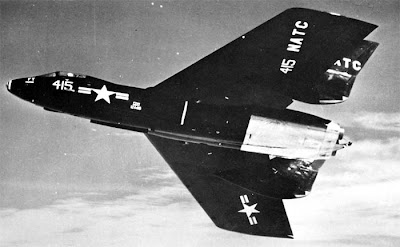 Eliminator” and “Gutless Cutlass” were not indicative of any fond feelings from the fleet. Schirra’s abilities as an aviator though shined in difficult tasks. Commenting later in life on flying the F7u-3 variant, he noted how with the slats at altitude he could turn inside any other fighter in existence even with afterburners. In 1956 and 1957, he flew F3H-2N Demons as Operations Officer of VF-124 onboard the aircraft carrier Lexington in the Pacific. In 1957 he attended the Naval Air Safety Officer School at the University of Southern California, and in 1958 and 1959 he completed test pilot’s training at the Naval Air Test Center at Patuxent River, Maryland, and was assigned to suitability development work on the XF-4H-1, predecessor to the F-4 Phantom. On April 2nd, 1959, Wally Schirra was chosen to be one of the 7 Mercury astronauts and a new and very public career began.
Eliminator” and “Gutless Cutlass” were not indicative of any fond feelings from the fleet. Schirra’s abilities as an aviator though shined in difficult tasks. Commenting later in life on flying the F7u-3 variant, he noted how with the slats at altitude he could turn inside any other fighter in existence even with afterburners. In 1956 and 1957, he flew F3H-2N Demons as Operations Officer of VF-124 onboard the aircraft carrier Lexington in the Pacific. In 1957 he attended the Naval Air Safety Officer School at the University of Southern California, and in 1958 and 1959 he completed test pilot’s training at the Naval Air Test Center at Patuxent River, Maryland, and was assigned to suitability development work on the XF-4H-1, predecessor to the F-4 Phantom. On April 2nd, 1959, Wally Schirra was chosen to be one of the 7 Mercury astronauts and a new and very public career began.
NASA
As a Naval officer, I was trained, essentially bred, to be a military aviator. I was a Naval officer on assignment, not an employee of NASA. – Wally Schirra
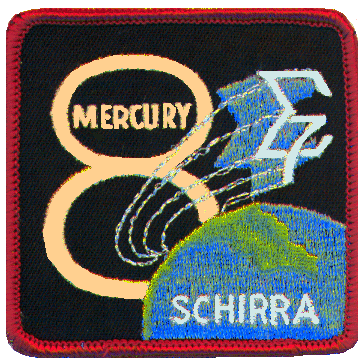 Wally Schirra was the third American to orbit the Earth in Sigma7 on 3 October, 1962. This was the longest orbital flight by America, lasting some 9+ hours. After Carpenter’s flawed reentry, the emphasis returned to engineering rather than science (Schirra even named his spacecraft “Sigma” for the engineering symbol meaning “summation.”) Much of the flight was spent in what Schirra called the “chimp configuration,” a free drift that tested the Mercury’s autopilot system. Other notable events during the flight included steering by the stars (he found this difficult), taking photographs, exercising with a bungeeÂcord device, observing lightning in the atmosphere, broadcasting the first live message from an American spacecraft to radio and TV listeners below, and making the first splashdown in the Pacific. This was the highest flight of the Mercury program, with an apogee of 283.24km (176mi), but Schirra later claimed to be unimpressed with space scenery as compared to the view from high-flying aircraft. “Same old deal, nothing new,” he told debriefers after the flight.
Wally Schirra was the third American to orbit the Earth in Sigma7 on 3 October, 1962. This was the longest orbital flight by America, lasting some 9+ hours. After Carpenter’s flawed reentry, the emphasis returned to engineering rather than science (Schirra even named his spacecraft “Sigma” for the engineering symbol meaning “summation.”) Much of the flight was spent in what Schirra called the “chimp configuration,” a free drift that tested the Mercury’s autopilot system. Other notable events during the flight included steering by the stars (he found this difficult), taking photographs, exercising with a bungeeÂcord device, observing lightning in the atmosphere, broadcasting the first live message from an American spacecraft to radio and TV listeners below, and making the first splashdown in the Pacific. This was the highest flight of the Mercury program, with an apogee of 283.24km (176mi), but Schirra later claimed to be unimpressed with space scenery as compared to the view from high-flying aircraft. “Same old deal, nothing new,” he told debriefers after the flight.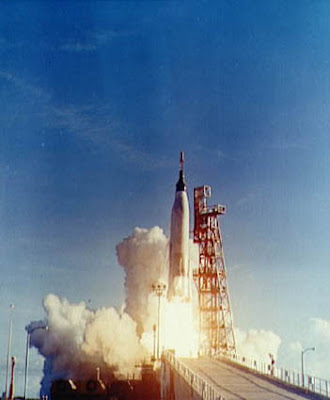
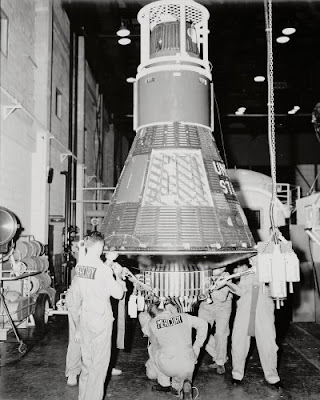
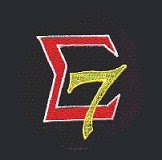 His next mission was with the two-man Gemini program, Gemini 6. Later in life he noted that while the Apollo was big, “like a truck” in handling, the smaller two-man Gemini capsule was just right in its handling on orbit. Gemini 6 was originally intended to be the first mission to dock with an Agena Target Vehicle. However, after a failure in the Agena target 6 minutes after its launch (when the crew of Gemini 6 was already sitting in their capsule waiting for their launch), the mission was canceled. In light of the failure, NASA decided to substitute an alternate mission: a meeting in space of two Gemini spacecraft. The new mission would be known as Gemini 6A, and would launch eight days after the launch of Borman and Lovell’s Gemini 7. Schirra and Stafford tried to join them, but their Titan 2 launcher shut down on the pad (Schirra did not eject, even though the countdown clock had started ticking-he felt no motion, and trusted his senses). Three days later, Gemini 6A made it into orbit. Using guidance from the computer as well as his own piloting, Schirra performed the space rendezvous with Gemini 7 on orbit on the afternoon of December 15. Once in formation, the two Gemini capsules flew around each other, coming within 0.3 meters of each other but never touching. The two spacecraft stayed in close proximity for five hours before finally separating. One of Gemini’s primary goals and a major milestone on the path to the moon, orbital rendezvous, was achieved.
His next mission was with the two-man Gemini program, Gemini 6. Later in life he noted that while the Apollo was big, “like a truck” in handling, the smaller two-man Gemini capsule was just right in its handling on orbit. Gemini 6 was originally intended to be the first mission to dock with an Agena Target Vehicle. However, after a failure in the Agena target 6 minutes after its launch (when the crew of Gemini 6 was already sitting in their capsule waiting for their launch), the mission was canceled. In light of the failure, NASA decided to substitute an alternate mission: a meeting in space of two Gemini spacecraft. The new mission would be known as Gemini 6A, and would launch eight days after the launch of Borman and Lovell’s Gemini 7. Schirra and Stafford tried to join them, but their Titan 2 launcher shut down on the pad (Schirra did not eject, even though the countdown clock had started ticking-he felt no motion, and trusted his senses). Three days later, Gemini 6A made it into orbit. Using guidance from the computer as well as his own piloting, Schirra performed the space rendezvous with Gemini 7 on orbit on the afternoon of December 15. Once in formation, the two Gemini capsules flew around each other, coming within 0.3 meters of each other but never touching. The two spacecraft stayed in close proximity for five hours before finally separating. One of Gemini’s primary goals and a major milestone on the path to the moon, orbital rendezvous, was achieved.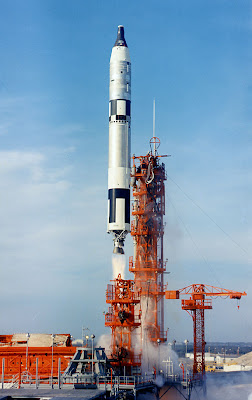
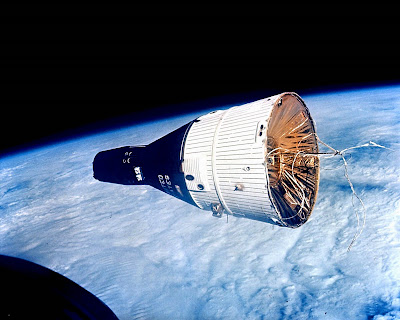
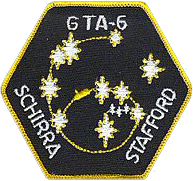
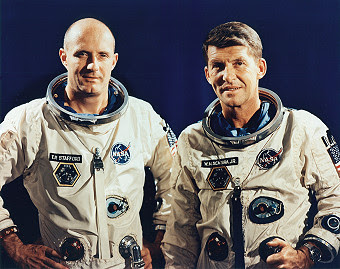 Apollo 1. Grissom, Chaffee and White. The American space program and the hopes of a nation lay literally in ashes on Pad 34 the morning after the sudden fire inside the capsule on 27 Jan 1967. Post fire investigations would highlight slipshod design, hurried production schedules, management that was out of touch and astronaut recommendations that went unheeded. A complete redesign of the Command Module was called for, to include moving away form the 100% pressurized oxygen atmosphere to one closer to normal atmospheric pressure and composition. Other design changes were instituted as well, including a new hatch. The next crew slated to fly would set the tone for forcing the manufacturers and NASA to “get it right.” Wally Schirra and his crew were the perfect crew to carry out just that kind of mission.
Apollo 1. Grissom, Chaffee and White. The American space program and the hopes of a nation lay literally in ashes on Pad 34 the morning after the sudden fire inside the capsule on 27 Jan 1967. Post fire investigations would highlight slipshod design, hurried production schedules, management that was out of touch and astronaut recommendations that went unheeded. A complete redesign of the Command Module was called for, to include moving away form the 100% pressurized oxygen atmosphere to one closer to normal atmospheric pressure and composition. Other design changes were instituted as well, including a new hatch. The next crew slated to fly would set the tone for forcing the manufacturers and NASA to “get it right.” Wally Schirra and his crew were the perfect crew to carry out just that kind of mission.
Too often I have been accused of a “mutiny” during the Apollo 7 mission. First I was on loan to NASA from the U.S.Navy, no Naval officer gave me an order during the mission. When one has command, orders that are not compatible with on board crew safety, may be rejected by the C.O. The flight directors made some mistakes that we noted. The final comment, in relation to all of the missions flown in space, no flight director ever risked his life. – Wally Schirra (emphasis added)
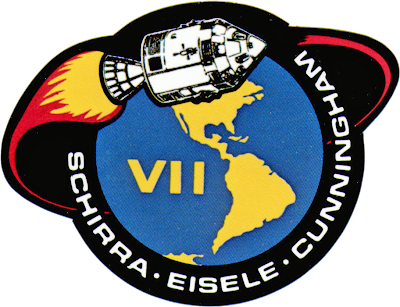 Apollo 7 was to be a confidence-builder in the wake of the Apollo 1 fire and re-design. As commander of the Apollo 7 mission, Schirra, would become the only astronaut to fly Mercury, Gemini and Apollo missions. His primary mission was to conduct the Earth-orbital shakedown of the command and service modules. Since it was not carrying a lunar excursion module (LM), Apollo 7 could be launched with the Saturn 1B booster rather than the much larger and more powerful Saturn V. Schirra wanted to give Apollo 7 the callsign “Phoenix” (the mythical bird rising from its own ashes) in memory to the loss of the Apollo 1 crew, but NASA higher-ups nixed that idea; fearing public backlash.
Apollo 7 was to be a confidence-builder in the wake of the Apollo 1 fire and re-design. As commander of the Apollo 7 mission, Schirra, would become the only astronaut to fly Mercury, Gemini and Apollo missions. His primary mission was to conduct the Earth-orbital shakedown of the command and service modules. Since it was not carrying a lunar excursion module (LM), Apollo 7 could be launched with the Saturn 1B booster rather than the much larger and more powerful Saturn V. Schirra wanted to give Apollo 7 the callsign “Phoenix” (the mythical bird rising from its own ashes) in memory to the loss of the Apollo 1 crew, but NASA higher-ups nixed that idea; fearing public backlash.
The Apollo hardware and all mission operations worked without any significant problems, and the Service Propulsion System (SPS), the all-important engine that would place Apollo in and out of lunar orbit, made eight nearly perfect firings. Even though Apollo’s larger cabin was more comfortable than Gemini’s, eleven days in orbit took its toll on the astronauts. The food was bad, and all three developed colds. As a result Schirra became irritable with requests from Mission Control. Schirra, calling upon his Navy training, exercised his duties as mission commander accordingly, making the call between what was really mission essential and what could be dispensed with to ensure crew safety and functionality. While it didn’t set well with NASA management (and popular history has it that as a result, none were scheduled for future missions as a result) the precedent was re-established with a bold-faced underline for future mission commanders. As it was, the missions goals, which included the first live TV broadcast from an American spacecraft (Gordo Cooper had broadcast slow-scan TV pictures from Faith 7 in 1963) and testing the LM docking maneuver, were all met and the mission successfully proved the space-worthiness of the basic Apollo vehicle.
Schirra retired from the Navy and left NASA in 1967, subsequently serving in a number of space and non-aerospace consultancy and business leadership positions. He is the author of two books – We Seven (co-authored with the 7 Mercury astronauts in 1960) and Schirra’s Space in 1988.
He passed away of natural causes at his home in California today, 3 May 2007.
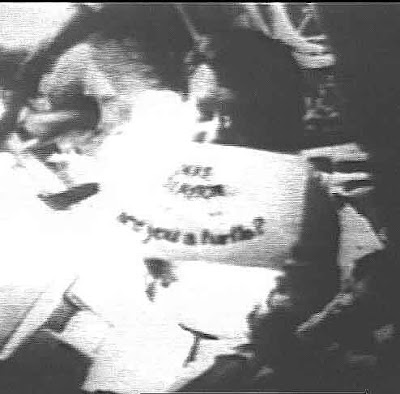
It has been said, elsewhere, that Wally Schirra was not an engineer – that might be disputed in terms of his collective aero-space experience – time in flight and on-orbit if you will. He did hold technical degrees from several institutions. He has been called a natural “seat-of-the-pants” flier. Perhaps. I believe he was both – gifted aviator and engineer, but he carried it all with the humor and spirit that to me characterizes Naval Aviation. Growing up I was a creature of the space program – living vicariously via TV, Life magazine and yes, even NASA press releases that I had subscribed to as a grade schooler. I vividly recall watching the early launches on our black and white TV set and could recount all manner of esoteric trivia from the program (just how many grade school kids both knew the fuel of the Titan 2 and how it worked?).
While fascinated by all the astronauts (and eventually getting to meet some in person – funny, they all turned out to be Naval Aviators…) Wally was one that captured my imagination. I think it was during Apollo 7 when the “are you a turtle” question was popped to Deke Slayton via TV that my then virgin brain made note that these Naval Aviators were a different sort (aided and abetted at the time by my adopted godfather, who flew Skyhawks in Vietnam) and later in life, came to more fully appreciate what Schirra brought to the program. He showed that one could be aviator, engineer, etc all rolled into a complete package, but more importantly, how one approached the mission. Clear-headed, sanguine in expected results and how to handle distractors. During the many helmet-fire missions I had later while flying the Hawkeye, there were times the vision of the him holding up the “Are you a turtle” sign popped into my head – I’d pause, smile and answer myself accordingly. Are you a turtle?
Rest in Peace Wally – let’s hope St. Peter got the answer right…
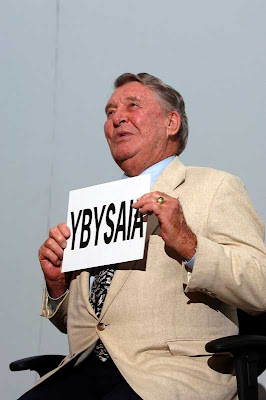 Sources:
Sources:
- http://en.wikipedia.org/wiki/Wally_Schirra
- http://www11.jsc.nasa.gov/Bios/htmlbios/schirra-wm.html
- http://www.daviddarling.info/encyclopedia/S/Schirra.html
- http://groups.msn.com/spacecowboysaloon/gemini6aamp7partiirendezvousinspace.msnw
- http://www-pao.ksc.nasa.gov/history/mercury/ma-8/ma-8.htm
- http://en.wikipedia.org/wiki/Gemini_6A
- http://en.wikipedia.org/wiki/Apollo_1
- http://en.wikipedia.org/wiki/Apollo_7

